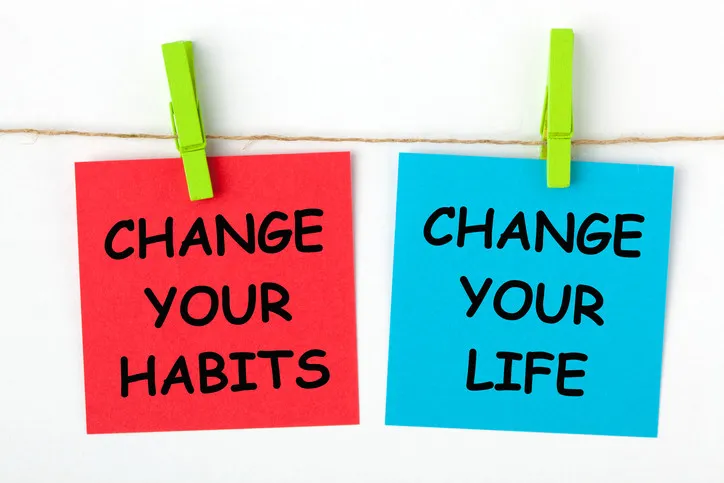In today’s world of diet fads, fitness trends, and endless advice about what we should or shouldn’t eat, finding balance with our bodies can feel like an uphill climb. We swing between control and indulgence, between motivation and guilt. Somewhere in that tug-of-war, we lose the simple joy of eating and moving mindfully.
Mindfulness offers a different path — one rooted not in restriction or punishment, but in awareness, compassion, and genuine self-care. It teaches us to tune into our bodies instead of fighting them, to notice hunger and fullness cues, and to make choices that nourish rather than numb.
This is not another “quick fix.” It’s a way of transforming how we relate to food, our bodies, and ourselves — gently and sustainably.
Table of contents
- 1. The Weight of a Busy World
- 2. What Is Mindfulness, Really?
- 3. The Science Behind Mindful Weight Balance
- 4. Re-Defining a “Healthy Habit”
- 5. Eating with Awareness: The Mindful Meal
- 6. The Emotional Side of Eating
- 7. Movement as Mindful Practice
- 8. Stress, Sleep, and Self-Compassion
- 9. The Inner Voice: From Critic to Coach
- 10. Creating Mindful Habits that Last
- 11. Mindfulness in Everyday Life
- 12. Mindfulness in the Modern Diet Culture
- 13. The Ripple Effect of Mindful Health
- 14. Simple Mindful Exercises for Everyday Use
- 15. When Progress Feels Slow
- 16. The Transformative Power of Mindful Living
- 17. A Gentle Reminder
1. The Weight of a Busy World
We live in an age of distraction. Our meals are often eaten in front of screens, in cars, or during rushed work breaks. We scroll while eating, binge to cope with stress, and skip meals when deadlines pile up.
This disconnection from the act of eating leads us to consume without awareness — not because we’re hungry, but because we’re tired, sad, anxious, or simply not paying attention. Over time, this unconscious relationship with food throws our internal balance off course.
Weight, after all, is not just about calories. It’s about connection. When we lose connection with our body’s natural rhythms, imbalance follows — physically, emotionally, and mentally.
Mindfulness helps us reconnect.
2. What Is Mindfulness, Really?
Mindfulness is the practice of being fully present in the moment, aware of what’s happening inside and around you — without judgment.
When applied to health and eating, mindfulness means slowing down, paying attention to what you eat, how it tastes, and how your body feels. It means noticing thoughts and emotions around food — guilt, fear, pleasure, satisfaction — without labeling them as good or bad.
Rather than controlling your body through force or fad diets, mindfulness invites you to listen to it. It’s a shift from “How can I lose weight?” to “How can I take care of myself in this moment?”
3. The Science Behind Mindful Weight Balance
Over the past decade, research has shown that mindfulness practices can help regulate weight and promote healthy behaviors without strict dieting.
Mindfulness:
- Lowers stress hormones such as cortisol, which are linked to weight gain and emotional eating.
- Improves self-regulation by strengthening brain regions associated with awareness and impulse control.
- Increases satisfaction with smaller portions because the brain registers food more fully when we eat slowly and attentively.
- Reduces binge-eating and mindless snacking by bringing awareness to emotional triggers.
Simply put, mindfulness helps us return to our body’s natural wisdom — the signals that tell us when to eat, when to stop, and what truly feels nourishing.
4. Re-Defining a “Healthy Habit”
Healthy habits aren’t about perfection. They’re about consistency and kindness.

A healthy habit is any action that moves you toward balance rather than burnout. It can be as simple as pausing before your meal, walking mindfully for ten minutes, or choosing water over soda because it feels right, not because it’s on a rule list.
When we practice mindfulness, habits form naturally because they’re grounded in awareness — not willpower. You start making choices that feel good rather than those driven by guilt or trends.
5. Eating with Awareness: The Mindful Meal
Let’s explore how mindfulness transforms the simple act of eating:
Step 1: Pause Before You Begin
Take a deep breath before your first bite. Look at your food — its colors, textures, and aromas. A short pause helps you shift from autopilot to awareness.
Step 2: Engage Your Senses
Notice how the food feels in your mouth, the flavors unfolding, the satisfaction building. Eating mindfully awakens gratitude and satisfaction that overeating can never deliver.
Step 3: Check in with Your Body
Ask yourself midway: “Am I still hungry, or am I satisfied?” When you listen closely, your body tells you exactly what it needs.
Step 4: Let Go of Judgment
Some days you’ll eat salad; other days you’ll crave pizza. Both are okay. Mindfulness helps you replace guilt with curiosity — “Why did I want that?” instead of “I shouldn’t have eaten that.”
This awareness creates space for balance and joy.
6. The Emotional Side of Eating
Food is never just food. It’s comfort, culture, memory, and emotion. When life feels heavy, we often turn to food to fill emotional gaps. But what we truly crave isn’t always what’s on our plate — it might be rest, comfort, connection, or reassurance.
Mindfulness invites us to pause before reaching for food and ask:
- “What am I feeling right now?”
- “Am I hungry for food, or for something else?”
- “What would truly nourish me in this moment?”
Maybe it’s a walk, a nap, a hug, or simply breathing through a difficult feeling. This shift doesn’t mean never eating for comfort; it means doing so consciously, with kindness and awareness.
7. Movement as Mindful Practice
Mindfulness isn’t limited to the dinner table — it extends to how we move our bodies.
So often, exercise is treated as punishment for eating or a chore on the to-do list. Mindful movement changes that story. It’s about listening to your body’s energy, respecting its limits, and finding joy in movement rather than obligation.
Try these mindful movement habits:
- Walk without your phone. Feel the rhythm of your steps, the air on your skin, the sights around you.
- Stretch gently and notice how each part of your body feels before and after.
- Choose movement that brings you joy — dance, yoga, cycling, or even gardening.
When you move mindfully, your body becomes not an enemy to be fixed, but a partner to be celebrated.
8. Stress, Sleep, and Self-Compassion
Weight balance isn’t just about food or exercise — it’s about the overall state of your nervous system.

When you’re stressed, your body releases cortisol, which triggers cravings for sugary or fatty foods. Sleep deprivation amplifies hunger hormones, making it harder to resist impulsive eating.
Mindfulness addresses these root causes by calming the mind and promoting better sleep patterns. Even a short daily meditation — five minutes of deep breathing — can reduce stress responses and improve decision-making.
And here’s the secret ingredient: self-compassion.
Mindful living isn’t about blaming yourself for slips; it’s about forgiving yourself, learning, and trying again. Lasting health begins not with discipline, but with kindness.
9. The Inner Voice: From Critic to Coach
Most of us carry an internal critic — that harsh voice that says, “You’ve failed again,” or “You’ll never look the way you should.”
Mindfulness helps us see that voice without believing it. When we observe it mindfully, it begins to lose power. We can then replace criticism with curiosity:
- “What triggered this reaction?”
- “What do I actually need right now?”
- “How can I support myself instead of scolding myself?”
Over time, your inner critic becomes an inner coach — one that guides, not punishes.
10. Creating Mindful Habits that Last
Real change happens in small, steady steps. Here’s how to build mindful habits for life:
1. Anchor Habits to Daily Routines
Practice mindfulness while brushing your teeth, drinking morning tea, or washing dishes. Everyday activities become reminders to be present.
2. Keep a Mindful Journal
After meals, jot down what you noticed — not just what you ate, but how you felt before and after. Patterns emerge, helping you make kinder choices.
3. Practice Gratitude
Before eating, pause to appreciate the food, the hands that grew it, and the body that will use it for energy. Gratitude turns eating into a sacred ritual, not a mindless act.
4. Set Intentions, Not Rules
Instead of rigid goals like “no sugar,” try intentions such as “I want to eat in a way that makes me feel energized.” Intentions foster awareness without guilt.
5. Celebrate Small Wins
Did you pause before eating? Stop when full? Choose rest over stress eating? Those moments matter — they’re steps toward lifelong change.
11. Mindfulness in Everyday Life
Mindfulness doesn’t stop with food or movement — it becomes a lifestyle. When you live mindfully:
- You savor conversations instead of rushing through them.
- You breathe before reacting in stress.
- You notice small joys — sunlight on your face, laughter, silence after a busy day.
This calm awareness reduces emotional eating and strengthens your connection to life’s natural rhythms — hunger, rest, joy, and peace.
12. Mindfulness in the Modern Diet Culture
Diet culture thrives on the message that you’re not enough — not thin enough, not disciplined enough, not perfect enough.
Mindfulness gently dismantles that narrative. It says, You are already enough. You don’t need to earn your worth through numbers on a scale or calories counted.
When you eat mindfully, you begin to respect your body’s cues more than society’s rules. You shift from chasing an image to nurturing your well-being. That’s true freedom — and it’s far more sustainable than any diet trend.
13. The Ripple Effect of Mindful Health
When you live mindfully, your balance inspires others. Family meals become calmer, conversations become deeper, and your example teaches children that food is not an enemy but a gift.
You stop seeing health as a battle and start seeing it as a relationship — one rooted in respect and care. The body responds beautifully to this shift, often stabilizing naturally when stress, guilt, and shame are released.
14. Simple Mindful Exercises for Everyday Use

a. The Three-Bite Pause
After three bites of your meal, pause and ask, “How do I feel?” You might notice flavors more vividly and adjust how much you eat.
b. Five-Minute Body Scan
Before bed, lie down and bring awareness from your toes to your head. This reduces tension and promotes restful sleep, which supports healthy metabolism.
c. Gratitude Breath
Each morning, take three slow breaths. With each exhale, silently say, “Thank you, body, for showing up for me today.”
Tiny practices like these build a lifelong connection with your body.
15. When Progress Feels Slow
Some days you’ll feel balanced and mindful. Other days, stress will win. That’s okay. Mindfulness teaches resilience — the ability to begin again, without shame.
Remember: progress isn’t linear. The goal isn’t perfection; it’s presence. Each time you catch yourself eating mindlessly or judging your body, pause, smile, and return to awareness. Every return is growth.
16. The Transformative Power of Mindful Living
Mindfulness brings harmony not only to your weight but to your entire life. When you eat with awareness, move with joy, and rest with compassion, balance becomes effortless.
You no longer chase health; you live it.
You no longer punish your body; you partner with it.
And you discover that balance isn’t found on a scale — it’s found in stillness, gratitude, and self-respect.
17. A Gentle Reminder
The next time you sit down to eat, remember:
You don’t need to count every calorie or control every craving.
You just need to be there — with your food, your breath, your body, and your heart.
Because when you eat mindfully, you’re not just feeding your body — you’re nourishing your life.
Stay Inspired on Your Mindfulness & Wellness Journey
If this article helped you see that true wellness begins within, here are a few more mindful reads to help you nurture your body, calm your mind, and stay balanced on your path to lasting health:
- The Power of Mindfulness: Finding Peace in the Present Moment – Learn how simple awareness practices can transform your daily life.
- Mindful Eating: How to Build a Healthier Relationship with Food – Discover how presence and gratitude can turn every meal into an act of self-care.
- Yoga for Mental Clarity: Poses That Calm the Mind and Boost Focus – Gentle movement to help release stress and reconnect with your inner calm.
- The 30-Day Mindfulness Challenge: Transforming Your Daily Life – Build balance and awareness with one small mindful step each day.
- The Science of Happiness: How Mindfulness Boosts Emotional Well-Being – Explore how staying present rewires your brain for joy and resilience.
